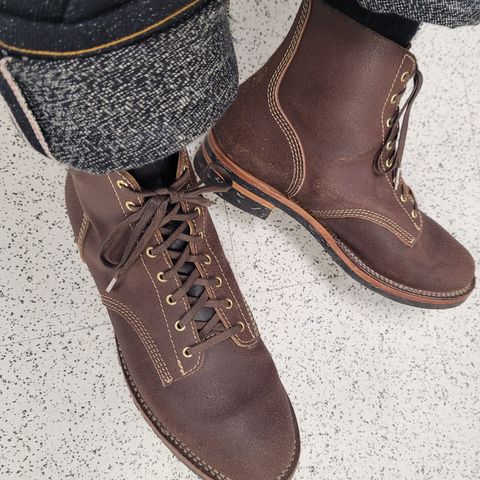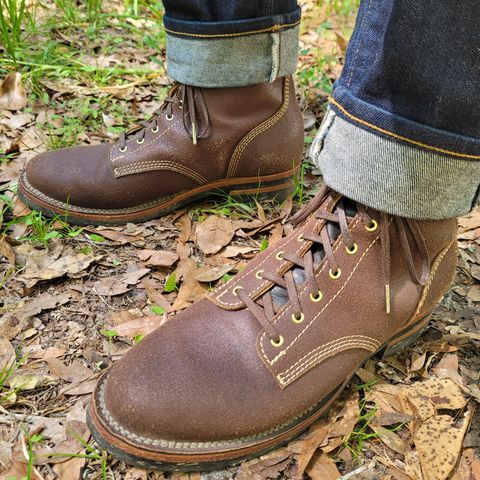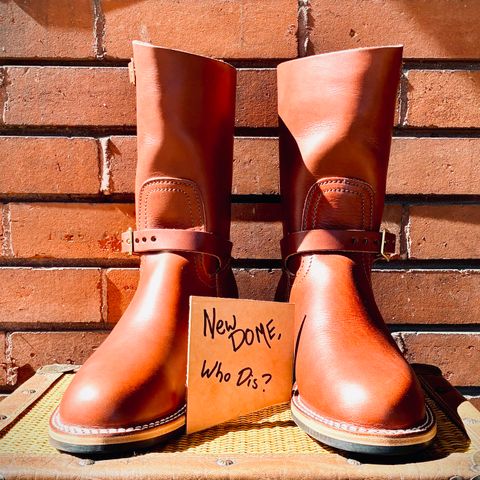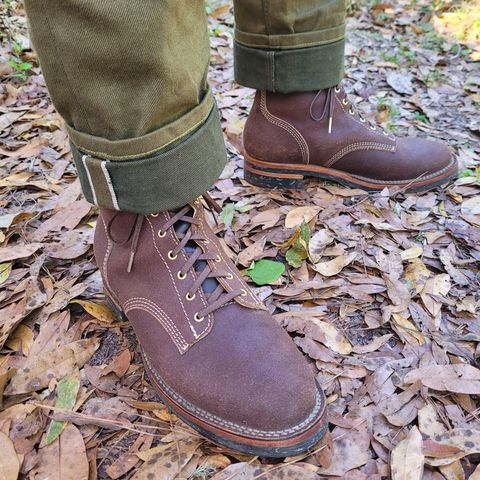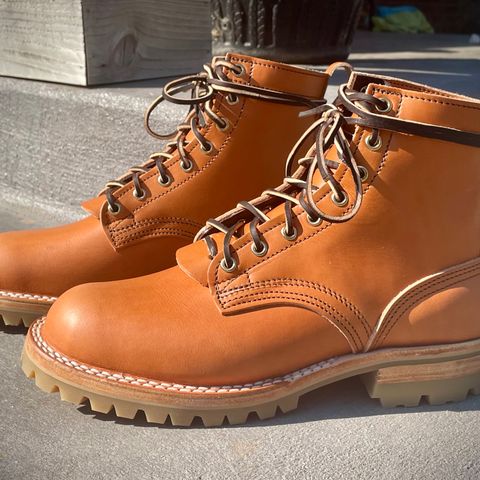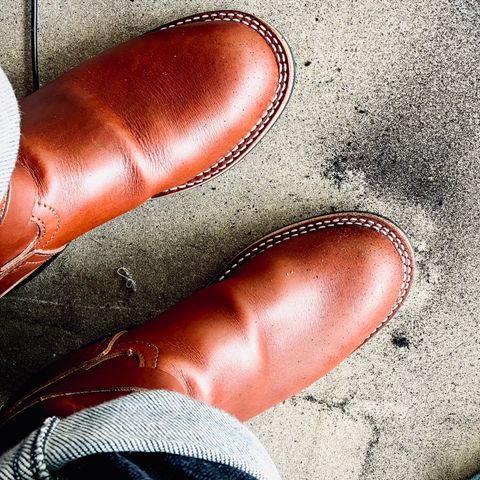About
Wickett & Craig English Bridle is a vegetable-tanned leather produced by Wickett & Craig, one of only two remaining vegetable tanneries in the United States. The leather undergoes a six-week tanning process using natural tannins from Mimosa and Quebracho tree barks, followed by drum dyeing and hot stuffing with waxes, oils, and tallows. Originally developed for equestrian gear, English Bridle leather has become a premium choice for heritage boots and high-end leather goods due to its smooth texture, flexibility, durability, and ability to develop a rich patina over time.
About
Wickett & Craig English Bridle is a vegetable-tanned leather produced by Wickett & Craig, one of only two remaining vegetable tanneries in the United States. The leather undergoes a six-week tanning process using natural tannins from Mimosa and Quebracho tree barks, followed by drum dyeing and hot stuffing with waxes, oils, and tallows. Originally developed for equestrian gear, English Bridle leather has become a premium choice for heritage boots and high-end leather goods due to its smooth texture, flexibility, durability, and ability to develop a rich patina over time.
Wickett & Craig, founded in 1867 and located in Curwensville, Pennsylvania, produces approximately 4,500,000 square feet of leather annually at their facility spanning more than 16 acres. The company specializes in traditional vegetable tanning methods, a labor-intensive process that produces leather with superior durability and natural aging characteristics. Their English Bridle leather is available in weights ranging from 2-3 oz to 12-14 oz and in ten standard colors.
Manufacturing process
The production of Wickett & Craig English Bridle leather follows a comprehensive vegetable tanning process that takes approximately six weeks from raw hide to finished leather. The tannery sources hides from North American cattle of European stock and processes them through multiple stages using traditional methods combined with modern quality control.
Pre-tanning and tanning
The manufacturing process begins with a two-day pre-tanning phase where hides are rehydrated and prepared for tanning. Workers remove hair and excess flesh using a fleshing machine before cutting the hides into two sides. The prepared hides then enter the tanning phase, where they soak for two weeks in tanning liquor containing a proprietary blend of Mimosa and Quebracho tree bark tannins. The facility maintains 72 vats that continually replenish and recirculate the tanning liquor to ensure consistent absorption. After tanning, the hides undergo sammying to remove excess moisture, receive a pre-grade assessment, and are split and shaved to desired thickness specifications.
Dyeing and fat liquoring
Following the tanning phase, the leather receives its color through drum dyeing, which develops deep, consistent colors throughout the material. The hot stuffing process distinguishes English Bridle leather from other vegetable-tanned products. During this stage, the leather is saturated with predetermined amounts of waxes, oils, and tallows, infusing the material to its core with conditioning agents. This hot stuffing creates the leather's characteristic waxy feel and enhances both its color depth and durability. Each tannery uses unique formulas for the hot stuffing process, creating variations in texture and finish between different producers.
Finishing
The finishing process begins with toggle drying on perforated stainless steel screens, followed by three days of air drying in climate-controlled space to prevent warping or uneven drying. Once dried, the leather undergoes staking, a mechanical process that softens the hides while maintaining their structural integrity. Workers then spray the leather with special waxes and apply polyurethane for abrasion resistance. The final step involves ironing to smooth the surface, followed by a final grading before shipment. The entire process, from pre-tanning through finishing, reflects Wickett & Craig's commitment to traditional craftsmanship while ensuring environmental certification by the Leather Working Group.
Physical characteristics
English Bridle leather from Wickett & Craig exhibits distinctive physical properties that result from its vegetable tanning and hot stuffing processes. The leather features a smooth texture with a flawless, even surface that reveals the natural grain of the hide. The hot stuffing process creates a characteristic waxy or oily feel, though the specific texture varies depending on the amount of conditioning agents used during production. Some batches present a more pronounced waxy texture, while others maintain a relatively dry finish.
Initial properties and break-in
Fresh from the tannery, English Bridle leather begins as a stiff material that requires proper care and an ample break-in period to reach its optimal characteristics. As the leather experiences regular use, it becomes soft and supple while retaining significant strength. The material responds well to conditioning and accepts dye readily due to its vegetable-tanned structure. The flexibility of the leather makes it suitable for applications requiring both beauty and structural integrity, from high-end leather goods to heritage footwear.
Aging and patina development
One of the defining characteristics of Wickett & Craig English Bridle leather is its aging behavior. The leather improves with use, developing a rich patina that deepens in color and character over time. The waxes and oils infused during hot stuffing provide weather resistance, allowing the leather to repel water while maintaining its appearance through regular wear. This combination of durability and aesthetic development makes the leather particularly valued in the heritage footwear market, where buyers appreciate materials that tell a story through their evolving appearance.
Specifications and availability
Wickett & Craig offers English Bridle leather in a comprehensive range of weights and grades to accommodate different applications and quality requirements. The leather is sold in sides and backs, with different pricing for each form.
Weight options
The company produces English Bridle leather in weights ranging from 2-3 oz for lighter applications to 12-14 oz for heavy-duty uses. Common weight options include 2.5/3oz, 3.5/4oz, 4.5/5oz, 5.5/6oz, 8/10oz, 10/12oz, and 12/14 oz. The average side measures 24-27 square feet, while the average back measures 18-20 square feet. Lighter weights suit luxury goods such as wallets, bags, and shoes, while heavier weights serve traditional applications including equestrian gear and work boots.
Grades and colors
The leather is available in three standard grades: Standard, Utility, and Special, with backs offered at an additional cost per square foot. Wickett & Craig produces English Bridle leather in an extensive color range, including Tan, Medium Brown, Dark Brown, Chestnut, Burgundy, Black, and Olive, along with Walnut, Cobalt, Buck Brown, Natural, Mustard, Chili Pepper, Navy, and Zucchini. For detailed information about specific colors, their characteristics, and applications, see the individual color articles. Custom splitting and refinishing services are available at additional cost for customers requiring specific thicknesses or surface treatments.
Applications
English Bridle leather from Wickett & Craig serves diverse applications across the leather goods and footwear industries, though its origins lie in equestrian equipment. The leather's name derives from its traditional use in horse tack, where its strength, flexibility, and weather resistance proved ideal for bridles, saddles, and straps that required durability under demanding conditions.
Heritage footwear
In recent years, Wickett & Craig has expanded into the heritage footwear market, supplying several prominent American boot manufacturers. The leather's characteristics make it particularly suitable for work boots and heritage boot styles where durability, aging behavior, and authentic materials matter to customers. Boot makers value the 6.5 oz weight for its balance of protection and flexibility, noting that the leather "looks and feels different than most boot leather" due to its traditional tanning and hot stuffing process. The material's ability to develop character through wear aligns with heritage footwear enthusiasts' appreciation for products that improve with age.
Leather goods and accessories
Beyond footwear, English Bridle leather remains popular for high-end leather goods and accessories. The material's smooth surface and ability to accept tooling and stamping make it suitable for belts, bags, wallets, and other leather accessories where craftsmanship and longevity are priorities. The leather burnishes to a remarkable finish and exhibits the "pull-up" effect characteristic of quality bridle leather, where oils migrate to flexed areas, creating depth and variation in color. Leather workers appreciate the material's response to traditional techniques while customers value its balance of formal appearance and practical durability.
References
"Vegetable Tanning". Wickett-Craig.
"English Bridle - Sides". Wickett-Craig.
"What is English Bridle Leather? How it's made and used". Buckleguy Blog.
"Wickett & Craig Leather". Buckleguy.
